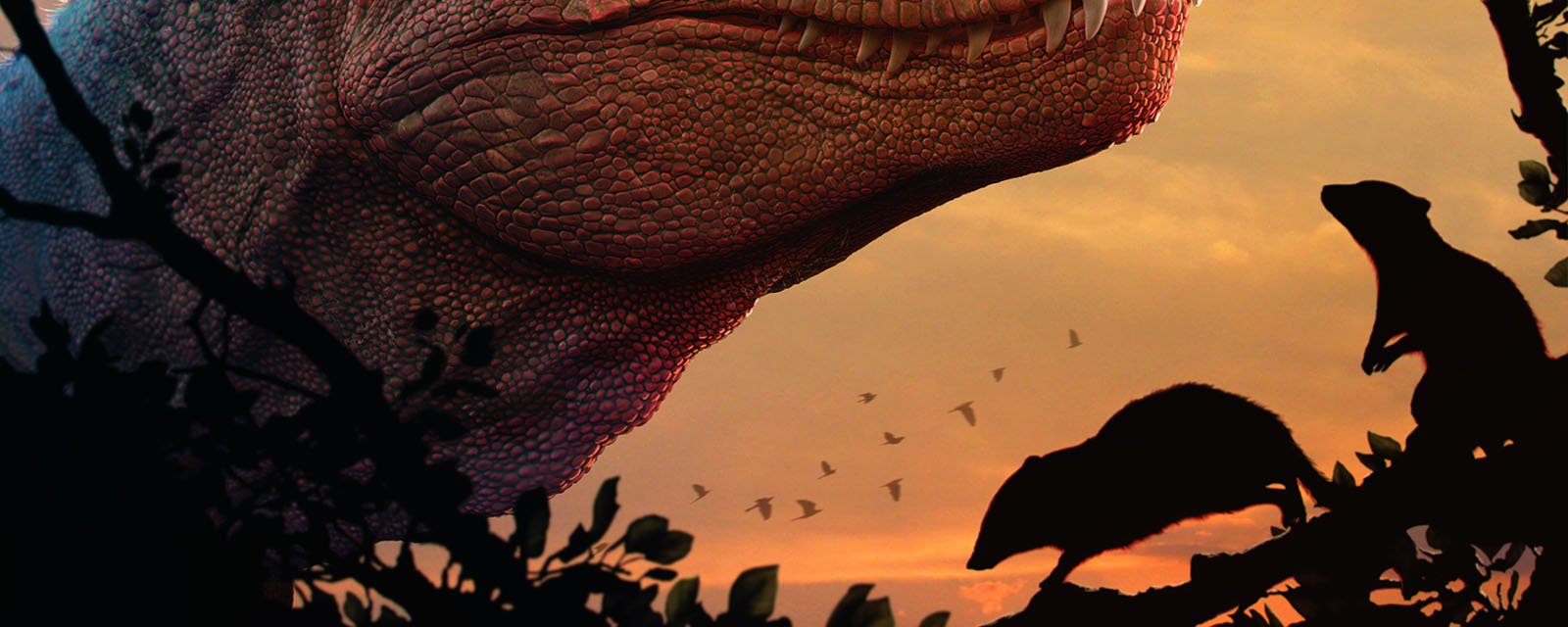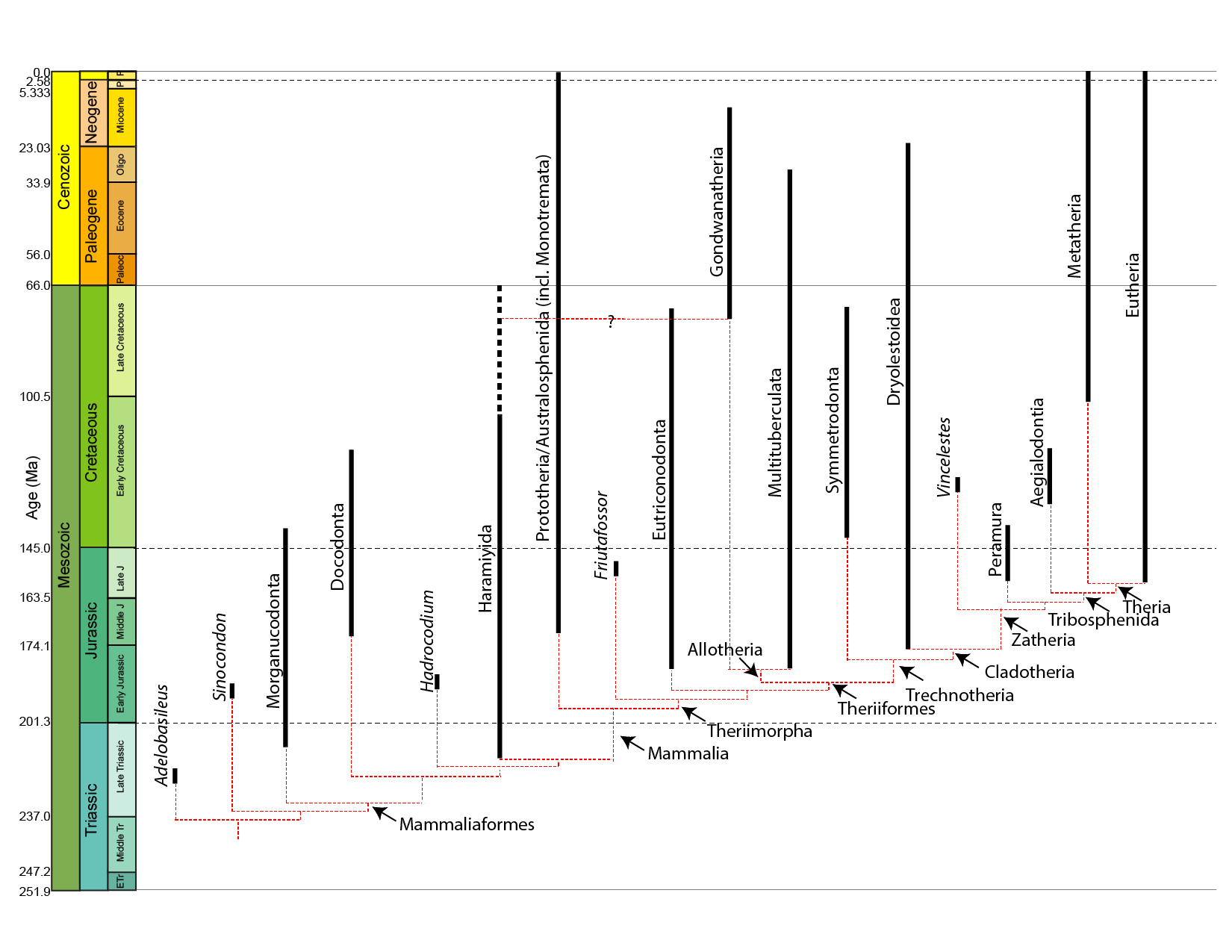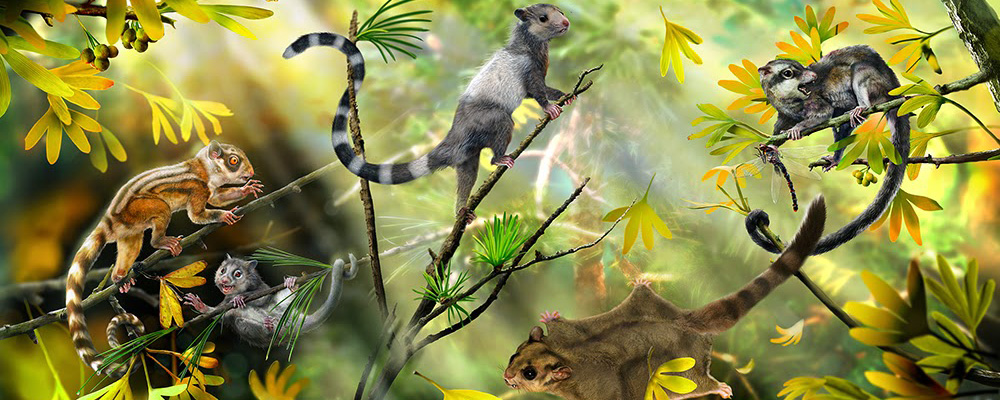


Key Points:
•Mammals are a branch of therapsid synapsids.
•Most of mammalian history occurred within the Mesozoic. Many features passed on to modern mammals (loss of good color vision; whiskers; etc.) seem to represent adaptations as mostly nocturnal animals during the Age of Dinosaurs.
•Mammals were quite diverse during the Mesozoic, evolving (multiple times!) into tree-climbing, burrowing, swimming, gliding, and other modes of life
•Many groups of mammals died out at the same extinction that took at the large dinosaurs, but others survived (including lineages which have since gone extinct
•One of the most important groups of organisms to evolve during the Mesozoic are the angiosperms (flowering plants). Unlike other seed plants, angiosperms use flowers to "bribe" insects and others to spread their pollen, and fruit to lure vertebrates (including herbivorous dinosaurs) to spread their seeds.
On land during the Mesozoic, there were plenty of organisms other than dinosaurs. Among the most important (especially for us!) were the mammals.
Mammals and their closest relatives (more properly Mammaliaformes, or sometimes "Mammaliformes") appear in fossil record not long after the dinosaurs, in Late Triassic.
Mammals are very advanced therapsids synapsids.
True mammals (Mammalia) found from Late Triassic onward (if the group Haramayida is part of Mammalia proper) or the Early Jurassic (if not). In the modern world, mammals are easily recognized by numerous synapomorphies:
Living mammals are divided into three clades:
Marsupialia and Placentalia are united as a clade called Theria (the "beasts"). Therians share the following synapomorphies:
Mammals are part of the amniote radiation that arose in the Carboniferous. Specifically, a clade Synapsida represents mammals and all taxa closer to mammals than to lizards and crocodiles (the taxa closer to lizards and crocs than to mammals form the clade Sauropsida). Sauropsids and synapsids (as sister taxa) arose at the same time, but it was the Synapsida that underwent an adaptive radiation first.
Synapsids are characterized by an an expanded infratemporal fenestra, among other traits. Primitive synapsids (sometimes referred to by the paraphyletic term "pelycosaurs") were fairly diverse in the Early and Middle Permian. Among the diversity included:
"Pelycosaur"-grade synapsids retained many basal amniote traits. Bone histology and predator-prey ratios strongly suggest these animals were still cold-blooded. At least some of these had a scaly body covering like sauropsids. While sprawling may be their normal mode of locomotion, tracks show they occasionally achieved a semi-sprawling "high walk" like today's crocodilians.
However, there are other ways in which they were precursors of more typical "mammalian" traits. There is evidence of parental care in the form of multiple half-grown individuals found in the same burrow as a fully-grown Microvaranops.
"Pelycosaurs" evolved themselves out of existence: they were displaced by their more derived descendants the Therapsida. Traditionally called "mammal-like reptiles", but they are not "reptiles" (sauropsids) and we mammals simply inherited therapsid traits. Therapsids have differentiated teeth: nipping incisors, biting canines, and grinding cheek teeth (not yet split between premolars and molars.) They typically had forelimbs more powerfully built than their hindlimbs. Therapsid diversity in the Middle and Late Permian include:
Therapsid posture was typically semi-sprawling.
Where Permian therapsids furry? This remains unresolved. There is skin impressions of one specimen that supposedly shows large scales, but these fossils are not published and is apparently from an environment that wouldn't record fur anyway. There is a coprolite from the Late Permian that has what are interpreted as hair filaments preserved in it, but these might conceivably by plant fragments or fungal hyphae.
Therapsids were the dominant terrestrial amniotes of the Late Permian, and thus suffered strongly in the Permo-Triassic mass extinction. Most clades within Therapsida were wiped out. Two major groups did survive and flourished in the Triassic: the two-tusked beaked Dicynodontia (culminating in rhino-sized latest Triassic Lisowicia) and the carnivorous, omnivorous, and herbivorous Cynodontia. It is among the cynodonts that the mammals arose.
It appears that vibrissae ("whiskers") and the rhinarium ("wet nose") that gives mammals their distinctive appearance was a very late trait in therapsid history. Although these don't typically fossilize, the reorganization of the passages for nasal nerves and blood vessels associated with the these features can be traced in therapsid history. It appears that whiskers and the rhinarium are only present in the closest relations to mammaliaforms among the earlier therapsids. (Intriguingly, a single gene MSX2 controls a number of mammalian traits: maintenance of whiskers and other hair, an enlarged cerebellum, the closure of the skull roof, and the presence of mammary glands! It may be that mutations of this gene represent a rapid transformation in "mammalifying" therapsids.)
Other cases of "mammalification" are more gradual. The shift from a multibone lower jaw to a single bone one, and with it the incorporation of the middle ear is well-documented in step-by-step changes throughout Therapsida. (In fact, new discoveries show that it evolved convergently between monotremes and therians, with some stem-monotremes and stem-therians still retaining a bony connection between the lower jaw and the middle ear bones.
On the other hand, there were still some distinctly non-mammalian traits among the non-mammaliaform therapsids. A recent discovery of the Early Jurassic tritylodont Kayentatherium shows that it had a clutch of at least 38 tiny babies rather than a more mammalian condition of smaller litter size.
Where do mammals start being mammals? Is it when deciduous teeth and a single lower jaw bone appear? Or with the crown-group? Paleomammalogists disagreed about this for generations. However, the current arrangement is to leave Mammalia as the crown group: the concestor of Monotremata, Marsupialia, and Placentalia, and all of its descendants. The more inclusive clade Mammaliaformes (defined as the concestor of Mammalia and Morganucodonta and all of its descendants) conforms closely to the traditional, broader definition of "Mammalia".
The oldest mammaliaforms show up in the Late Triassic, not too long after the oldest dinosaurs and pterosaurs. The oldest crown-mammals show up in the Early Jurassic or the Late Triassic, depending on the phylogenetic position of the Haramyida. Under either concept, mammals spent more of their history in the shadow of the dinosaurs than as the dominant group of terrestrial amniotes.
Mammaliaformes were quite diverse throughout the Mesozoic:

While fur isn't yet confirmed in moganucodonts, their tiny body size suggests it was necessary (especially if they were endothermic). Fur is definitely present in the clades Docodonta and Haramiyida.
Mesozoic mammals may have been "children of the night". The phylogenetic distribution of behavior, of specialized eye pigments, and of pupil shape strongly suggest that the concestor of all mammals (and of all mammaliaforms) was nocturnal. (Cathemerality--activity during both day and night--evolves later and dominates for larger-bodied mammals, and diurnality--activity limited to daytime--being rare, and most common in primates.)
Most Mesozoic mammals very small (shrew-to-house cat sized, with a few badger-sized forms in the Cretaceous); mammals only become large AFTER extinction of non-avian dinosaurs.
The oldest mammaliaforms of the Late Triassic and Early Jurassic were fairly small. But by Middle and Late Jurassic, there were already some specialized mammals:
A curious discovery in Mesozoic mammals is that many groups have an ankle spur homologous to that in modern monotremes. It isn't certain if they were poisonous and/or if they were limited to males. So even in this "monotreme" trait is not a synapomorphy of this clade, but rather a retention of a symplesiomorphy which is lost in the derived Theria.
We tend to think of Mesozoic mammals as being at the mercy of dinosaurs, but in at least one case the mammals had the upper hand. The badger-sized eutriconodont Repenomamus contains in its gut the remains of several baby dinosaurs.
Some major groups of Jurassic and Cretaceous mammals:
Prototheria (sometimes called "Australosphenida"; monotremes and their extinct relatives):
Eutriconodonta (eutriconodonts):
Allotheria (allotheres):
Among the various clades of mammals in the Mesozoic are early monotremes and stem-members of the two therian groups. Metatheria is the total-group for Marsupialia, and is known from the Early Cretaceous onward. Eutheria, the total-group for Placentalia, goes all the way back to the earliest Late Jurassic. (Of course, as its sister taxon, Metatheria has to extend as far back in time as Eutheria, but we haven't found or identified the Jurassic metatherians yet.) While Marsupialia proper isn't known until the earliest Cenozoic, fossils of crown Placentalia are known before the K/Pg extinction (and based on genetic divergence many of the branches may have been present much earlier in the Cretaceous). Additionally, there are therians (or near-therians) not certainly placed in either group, including one of the largest Cretaceous mammals (Argentina's Patagomaia).
Metatheria (marsupials and their extinct relatives):
Eutheria (placentals and our extinct relatives):
Prototheres, allotheres (as multitubercultates), metatheres (including the first marsupials), and eutheres (including the first placentals) all survived the great extinction event at the end of the Cretaceous. A few other groups survived as well, but the majority of Mesozoic mammal lineages perished in that extinction event.
The base of the food chain on land is plants. They use photosynthesis to take in sunlight, carbon dioxide, and water and combining them to produce glucose and oxygen (in other words, the reverse of the aerobic respiration equation).
Plants at the dawn of the age of dinosaurs were very different from those of the modern world: not so much of what was there as what wasn't. There was no grass, no grain, no fruit, no flowers. But by the end of the Mesozoic, these were present.
Primitive plants are spore plants. Spore plants are a paraphyletic grade: some are more closely related to seed plants than are others. Spore plants first colonized land in the early Paleozoic Era.
They reproduce by releasing spores, which settle onto moist surfaces, grow into plants that produce sex cells which meet in the thin film of water, and join to produce a new spore-producing plant. (Note that this is somewhat analogous to amphibian-grade tetrapods: plants that live their life on land, but need to put their sex cells in water to reproduce.)
Various sorts of spore plants exist:
All of these were present in the Mesozoic. For most of the Mesozoic the dominant ground cover was ferns, and tree ferns were fairly important trees in the Triassic and Jurassic.
Spore plants lack true wood (tree ferns cheat by having many stalks growing right next to each other for support), nor do they have complex root systems.
Those traits, however, ARE present in the seed plants. Seed plants first appear in the mid-Paleozoic Era, and become the dominant land plants in the Permian Period of the Paleozoic Era.
They reproduce by releasing male sex cells (carried in pollen) which land on female sex organs, join with female sex cells, produce a fertilized seed, which can then be released from the plant to land in the soil and germinate on its own. (This is analogous to the amniotic egg in tetrapods, allowing plants to colonize further inland into drier regions.)
All non-flowering seed plants are traditionally grouped into a paraphyletic grade, the "gymnosperms": some extinct gymnosperms are more closely related to flowering plants than to other gymnosperms. The living gymnosperms do form a clade (Acrogymnospermae). Various sorts of gymnosperms exist:
As today, gymnosperms were an important group of land plants in the Mesozoic. In fact, they were even more common then! Ginkgoes, dawn redwoods, cycads, and bennettitaleans (all rare or extinct today) were major parts of the flora, and major sorts of dinosaur food.
Some gymnosperms (conifers, cycads) wrap their seeds in a fleshy coating, and some (bennitataleans, cycads) had specialized structures around their female sex organs to attract insects. But only in the next group do we get true fruit and true flowers.
Flowering plants, called the angiosperms or anthophytes are the major clade of modern plants. With rare exceptions, if you have eaten a plant, it was an angiosperm. Angiosperms are a clade within the seed plants. Their mode of reproduction is to develop a specialized set of both male and female sex organs within a flower; pollinators are lured to the flower, pick up pollen, have pollen rub off on the flower of another plant, where they fertilize the female sex cells, and a seed is made. That seed is covered by a coating of fleshy or nutty tissue derived from the ovaries: the fruit.
The basic angiosperm life cycle hinges on co-evolution with animals:
If angiosperms evolved flowers and fruit in the Cretaceous, who were their target audiences?
So thank the insects for flowers, and thank the dinosaurs for fruit.
The rise of the angiosperms occurs about the same time that low-browsing herbivorous dinosaurs (ankylosaurs, iguanodontians, rebbachisaurids) become dominant over medium (stegosaur) and high (typical sauropod) browsers. Are these changes linked? Although angiosperms were present in the Early Cretaceous, they seem to have been relatively rare then, and unlikely to have been a major food source for these groups at first. But it may be that increase in low-browsing forms favored the spread of herb-sized angiosperms.
By the Late Cretaceous many modern clades of angiosperms were present (mangolias, rose-relatives, maples, etc.). Also during this time the first grass appears. Grasses include not only the stuff that grows in lawns and meadows, but all the grain-producing plants (wheat, barley, etc.), as well as bamboo. Their flowers are extremely small, and they are often wind-pollinated rather than by the help of insects.
Grasses grow from the base of the leaf rather than the tip. They often have little bits of silica in them to persuade herbivores not to eat them. Recent discoveries in both Laurasia and Gondwana: the latter were found in titanosaur sauropod coprolites! So at leastsome Cretaceous dinosaurs were grass eaters. However, grasses seem to have been relatively rare in the Mesozoic, and did not form grasslands until much later. Ground cover in the later Mesozoic was a mixture of ferns and herbaceous angiosperms. So as far as we know, no dinosaur other than birds ever wandered in prairies or savannahs: these appear much later, long after the end of the Mesozoic.
